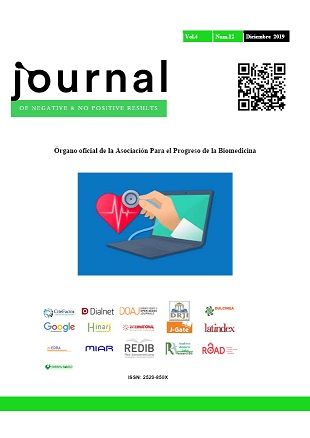Learning styles determination enrolled to the engineering area on students of first-year, UAO
DOI:
https://doi.org/10.19230/jonnpr.3073Keywords:
Learning styles, Engineering, School dropout, Teaching-LearningAbstract
Objective. The objective of this work is to determine the predominant learning styles in the first year students assigned to the Engineering area of the Universidad Anáhuac Oaxaca.
Method. This is a descriptive cross-sectional study, where the target sample is determined by students assigned to the area of Engineering, for which the Learning Styles Index © © (ILS ©) instrument was used, and the data analysis will be carried out through Excel®.
Results. The Learning Styles Index © (ILS ©) instrument was applied to 20 first-year students of the School of Engineering of the Universidad Anáhuac Oaxaca, of which 45% are male and 55% female, with an average age of 18.5 years, 50% of them are in the active-reflexive dimension, being the preferential stimulus 100% of visual type, for the dimension of processing and understanding of information, they are mostly sequential.
Conclusions. It was obtained that first year students have preference for a sequential-visual order specific to the area of engineering, these data are important to be able to direct the teaching styles by means of the modification of the didactic strategies of the teachers of the engineering area, it is an even complicated task since not all teachers have the openness to adapt their teaching styles based on the predominant learning styles in the group, which has been reflected for years in the University through an increase in the dropout from the area.
Downloads
References
Aguilera PE. Los estilos de enseñanza, una necesidad para la atención de los estilos de aprendizaje en la educación universitaria. Estilos de Aprendizaje 2012;10(10):79-87.
Yacub B, Patron G, Agámez ME, Acevedo D. Estilos de aprendizaje y su relación con repitencia y retraso académico en Ingeniería Biomédica, Electrónica e Industrial. Entre Ciencia e Ingeniería 2018;12(23):72-77.
López-Aguado M. Estilos de aprendizaje. Diferencias por género, curso y titulación, Estilos de Aprendizaje 2011;7(7):109‐134.
Gutiérrez M, García JL, Vieira DM. Estudio de las variables que influyen en los estilos de aprendizaje de diferentes grupos de alumnos del grado magisterio de la Universidad de Valladolid, España, Estilos de Aprendizaje 2012;10(10):55-64.
Kolb, D. Inventario de los estilos de aprendizaje: Inventario autoevaluativo y su interpretación. 1981.
Freiberg-Hoffmann A, Berenguer D, Fernández-Liporace M, Ledesma R. Estillos de aprendizaje en estudiantes universitarios de Buenos Aires. Revista psicodebate: psicología, cultura y sociedad 2017;17(1):9-34.
Crissman J, Lee Upcraft M. The keys to first-year student persistence. En M. Lee Upcraft, J. Gardner & B. Barefoot (Eds.). Challenging and supporting the First-Year student. A handbook for improving the First-Year of college 2005:27-46.
Seabi J, Payne J. Effects of identity processing styles on academic achievement of First-Year university students. International Journal of Educational Management 2013;27(3):311-322.
Tinto, V. Research and practice of student retention: What’s next? Journal College Student Retention 2007;8(1):1-19.
Cronbach L, Snow R. Aptitudes and instructional methods: a handbook for research on interactions 1975.
Kostolányová, K. Theoretic principles of the adaptive teaching process. New Educational Review 2013;34(4):208-219.
Kostolányová K, Šarmanová J, Takács O. (2011). Classification of learning styles for Adaptive Education. New Educational Review ; 23(1), pp. 199-212
Snow R. Aptitude theory: Yesterday, today, and tomorrow. Educational Psychologist 1992;27:5-32.
Isoc D, Isoc T. A new adaptive teaching method for engineering school. Journal Plus Education / Educatia Plus 2010;6(2):124–131.
Ventura A, Palou I, Széliga C. Estilos de aprendizaje y enseñanza en ingeniería: una propuesta de educación adaptativa para primer año. Revista Educación en Ingeniería 2014; 9(18):178-89.
Díaz Álvarez C. Mapas mentales y estilos de aprendizaje: Aportes a la enseñanza/aprendizaje en un espacio formativo en ingeniería. Revista Educación en Ingeniería 2013;8(16):45-52.
Evans C, Cools E. Applying styles research to educational practice. Learning and Individual Differences 2011;21:249-254.
Paz Penagos H. Aprendizaje autónomo y estilo cognitivo: diseño didáctico, metodología y evaluación. Revista Educación en Ingeniería 2014;9(17):5365.
Monereo C, Castelló M, Clariana M, Palma M, Pérez ML. Estrategias de enseñanza y aprendizaje Formación del profesorado y aplicación en la escuela 1999.
Aragón M, Jiménez Y. Diagnóstico de los estilos de aprendizaje en los estudiantes: estrategia docente para elevar la calidad educativa. Revista de Investigación Educativa 2009; 9: 1-21.
Martínez Geijo P. Estilos de Enseñanza: Conceptualización e Investigación. (en función de los estilos de aprendizaje de Alonso, Gallego y Honey). Review of Learning Styles 2009; 3(2):1-5.
Trelles H, Alvarado H, Montánchez M. Estrategias y estilos de aprendizaje y su relación con el rendimiento académico en estudiantes universitarios de psicología educativa. Revista Kilkana Sociales 2018; 2(2): 9-16.
Published
Issue
Section
License
All accepted originals remain the property of JONNPR. In the event of publication, the authors exclusively transfer their rights of reproduction, distribution, translation and public communication (by any sound, audiovisual or electronic medium or format) of their work. To do so, the authors shall sign a letter transferring these rights when sending the paper via the online manuscript management system.
The articles published in the journal are freely used under the terms of the Creative Commons BY NC SA license, therefore.
You are free to:
Share — copy and redistribute the material in any medium or format
Adapt — remix, transform, and build upon the material
The licensor cannot revoke these freedoms as long as you follow the license terms.
Under the following terms:
Attribution — You must give appropriate credit, provide a link to the license, and indicate if changes were made. You may do so in any reasonable manner, but not in any way that suggests the licensor endorses you or your use.
NonCommercial — You may not use the material for commercial purposes.
ShareAlike — If you remix, transform, or build upon the material, you must distribute your contributions under the same license as the original.
No additional restrictions — You may not apply legal terms or technological measures that legally restrict others from doing anything the license permits.

This work is licensed under a Creative Commons Attribution-NonCommercial-ShareAlike 4.0 International License

























